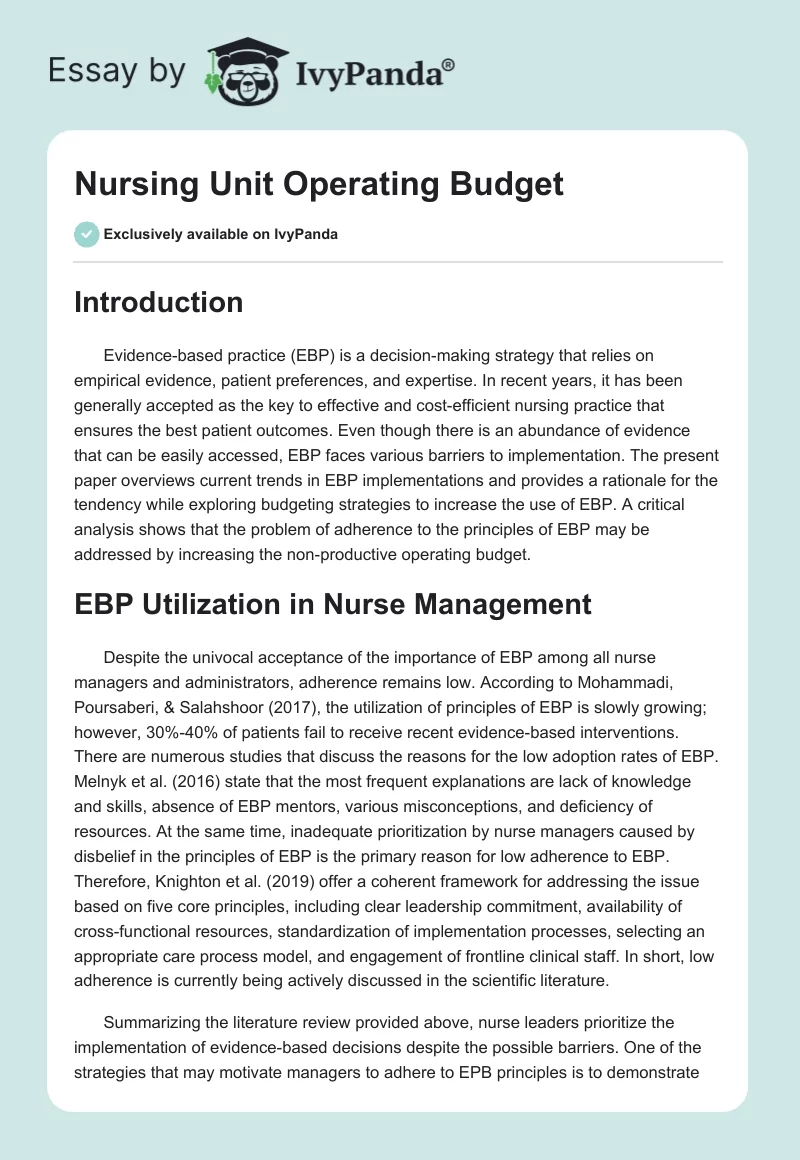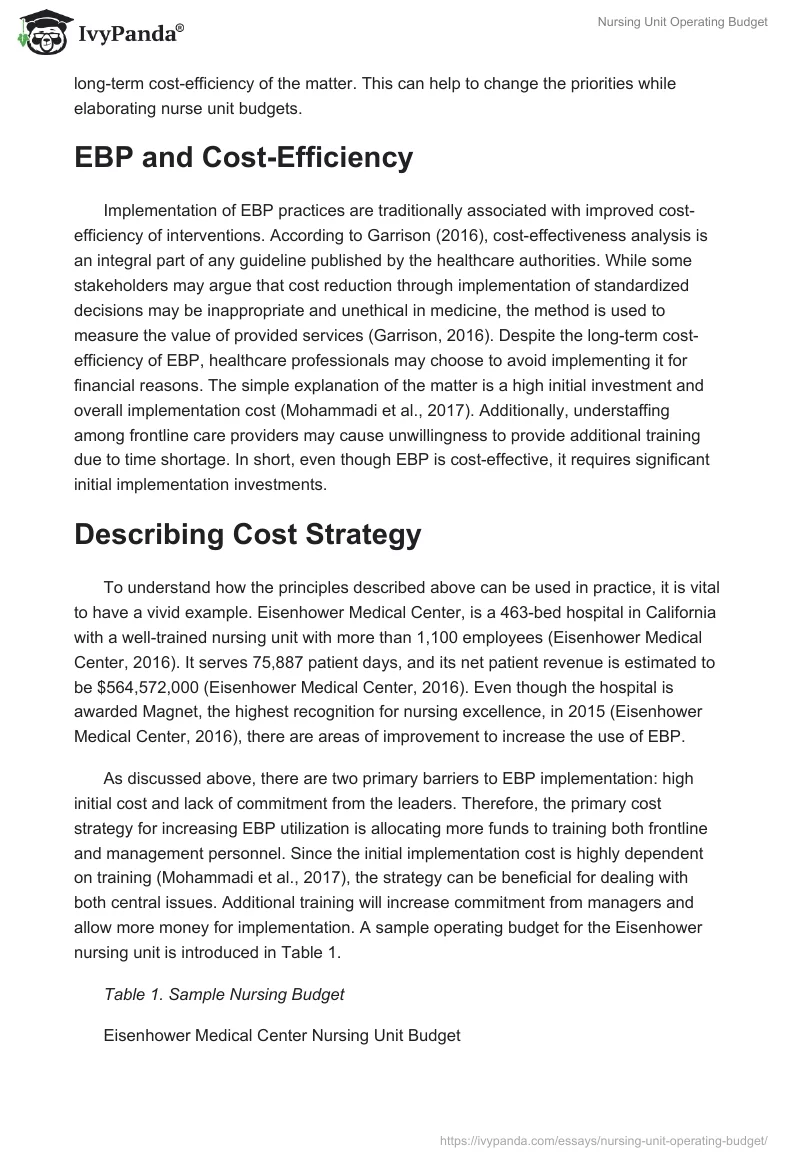Introduction
Evidence-based practice (EBP) is a decision-making strategy that relies on empirical evidence, patient preferences, and expertise. In recent years, it has been generally accepted as the key to effective and cost-efficient nursing practice that ensures the best patient outcomes. Even though there is an abundance of evidence that can be easily accessed, EBP faces various barriers to implementation. The present paper overviews current trends in EBP implementations and provides a rationale for the tendency while exploring budgeting strategies to increase the use of EBP. A critical analysis shows that the problem of adherence to the principles of EBP may be addressed by increasing the non-productive operating budget.
EBP Utilization in Nurse Management
Despite the univocal acceptance of the importance of EBP among all nurse managers and administrators, adherence remains low. According to Mohammadi, Poursaberi, & Salahshoor (2017), the utilization of principles of EBP is slowly growing; however, 30%-40% of patients fail to receive recent evidence-based interventions. There are numerous studies that discuss the reasons for the low adoption rates of EBP. Melnyk et al. (2016) state that the most frequent explanations are lack of knowledge and skills, absence of EBP mentors, various misconceptions, and deficiency of resources. At the same time, inadequate prioritization by nurse managers caused by disbelief in the principles of EBP is the primary reason for low adherence to EBP. Therefore, Knighton et al. (2019) offer a coherent framework for addressing the issue based on five core principles, including clear leadership commitment, availability of cross-functional resources, standardization of implementation processes, selecting an appropriate care process model, and engagement of frontline clinical staff. In short, low adherence is currently being actively discussed in the scientific literature.
Summarizing the literature review provided above, nurse leaders prioritize the implementation of evidence-based decisions despite the possible barriers. One of the strategies that may motivate managers to adhere to EPB principles is to demonstrate long-term cost-efficiency of the matter. This can help to change the priorities while elaborating nurse unit budgets.
EBP and Cost-Efficiency
Implementation of EBP practices are traditionally associated with improved cost-efficiency of interventions. According to Garrison (2016), cost-effectiveness analysis is an integral part of any guideline published by the healthcare authorities. While some stakeholders may argue that cost reduction through implementation of standardized decisions may be inappropriate and unethical in medicine, the method is used to measure the value of provided services (Garrison, 2016). Despite the long-term cost-efficiency of EBP, healthcare professionals may choose to avoid implementing it for financial reasons. The simple explanation of the matter is a high initial investment and overall implementation cost (Mohammadi et al., 2017). Additionally, understaffing among frontline care providers may cause unwillingness to provide additional training due to time shortage. In short, even though EBP is cost-effective, it requires significant initial implementation investments.
Describing Cost Strategy
To understand how the principles described above can be used in practice, it is vital to have a vivid example. Eisenhower Medical Center, is a 463-bed hospital in California with a well-trained nursing unit with more than 1,100 employees (Eisenhower Medical Center, 2016). It serves 75,887 patient days, and its net patient revenue is estimated to be $564,572,000 (Eisenhower Medical Center, 2016). Even though the hospital is awarded Magnet, the highest recognition for nursing excellence, in 2015 (Eisenhower Medical Center, 2016), there are areas of improvement to increase the use of EBP.
As discussed above, there are two primary barriers to EBP implementation: high initial cost and lack of commitment from the leaders. Therefore, the primary cost strategy for increasing EBP utilization is allocating more funds to training both frontline and management personnel. Since the initial implementation cost is highly dependent on training (Mohammadi et al., 2017), the strategy can be beneficial for dealing with both central issues. Additional training will increase commitment from managers and allow more money for implementation. A sample operating budget for the Eisenhower nursing unit is introduced in Table 1.
Table 1. Sample Nursing Budget
The budget uses Hours per Patient Day (HPPD) and Full-Time Equivalent (FTE) metrics. HPPD is calculated to be six, and FTE is 455,322. This budget has increased the non-productive to productive cost ratio to provide more opportunities for training. Apart from training, non-productive costs include holiday pay, sick leave, and non-work-related internet usage. Therefore, this line of expenditures is to be thoroughly clarified when the actual budget is proposed.
Conclusion
Even though nurse leaders and managers believe that the use of EBP is vital to improving the quality of care, its use remains limited. The primary reason for the matter is inadequate prioritization of financial resources caused by nurse leaders’ disbelief in the cost-efficiency of the practice and unwillingness to pay the initial implementation cost. The issue can be addressed by allocating more budget money to non-productive personnel costs. However, the non-productive cost should be controlled to avoid overspending on non-training matters.
References
Eisenhower Medical Center. (2016). 2015 nursing annual report. Web.
Garrison, L. (2016). Cost-effectiveness and clinical practice guidelines: Have we reached a tipping point?—An overview. Value in Health, 19(5), 512-515.
Knighton, A., McLaughlin, M., Blackburn, R., Wolfe, D., Andrews, S., & Hellewell, J., … Srivastava, R. (2019). Increasing adherence to evidence-based clinical practice. Quality Management in Health Care, 28(1), 65-67.
Melnyk, B., Gallagher-Ford, L., Thomas, B., Troseth, M., Wyngarden, K., & Szalacha, L. (2016). A study of chief nurse executives indicates low prioritization of evidence-based practice and shortcomings in hospital performance metrics across the United States. Worldviews on Evidence-Based Nursing, 13(1), 6-14.
Mohammadi, M., Poursaberi, R., & Salahshoor, M. (2017). Evaluating the adoption of evidence-based practice using Rogers’s diffusion of innovation theory: a model testing study. Health Promotion Perspectives, 8(1), 25-32.


